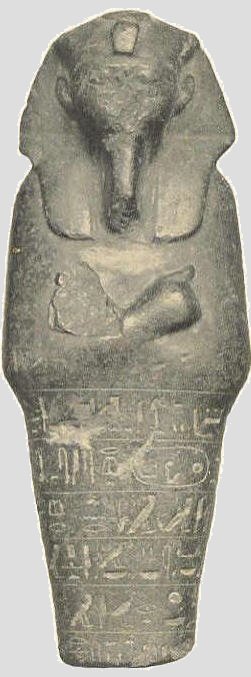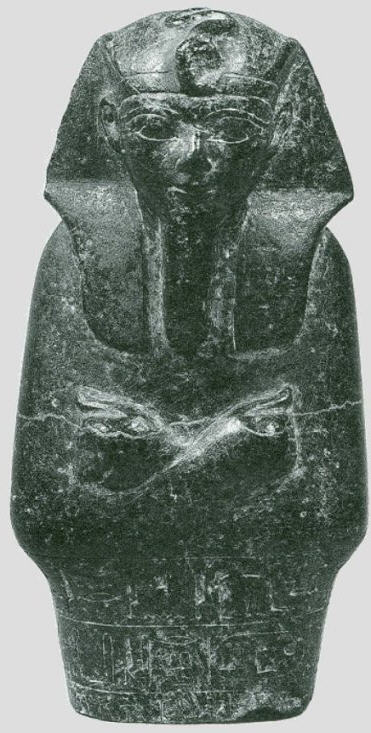|
Maat-ka-Ra Hatshepsut |
last update:
26.03.2008
|
|
Shabti |
|
| Among other things the Rijksmuseum
Meermanno-Westreenianum in The Hague owns a small collection of
Old-Egyptian objects (Boddens Hosang, in 1989). The collection dates
back into the 19th century and its origin is to be found in the
collections of the Baron van Westreenen and his great-uncle Meerman.
Westreenen purchased the objects at auctions or from individuals in
France, Germany, England, Belgium and Italy. Although he recorded carefully his purchases the origin of numerous objects seems unclear.
|
|
To the objects of the collection also belongs a shabti of the queen
Hatshepsut which was called to my attention by Mr. B. Lieffering. This is one of 4 shabtis which are
possibly assigned to Hatshepsut. Another
one is located in the Musée d'Aquitaine, Bordeaux (inventory no. 9087;
Orgogozo, 1992a, 1992b)
which appears to be virtually
identical with the example in The Hague (Loeben, 1997; Eaton-Krauss,
1999) - and it is also of unknown
providence.
|
|
The City Museum of Bristol owns two figures made of faience (Grinsell,
1972; inventory Nos H4045 and H4056)
which are listed in the catalogue as shabtis of Hatshepsut because her prenomen (= throne
name) occurs on the figures. According to
information of the museum both figures come from Deir el-Bahari,
had been bought there by a tourist called F. Fox Tuckett, probably at a trader, and
were given to the museum in 1930 (entry number
7198). However, both figures which are approx. 11 cm high carry unambiguously the title of a God's
Wife. Hence, most likely these shabtis belong to the Queen Maatkara-Mutemhat,
God's Wife of Amun and daughter of Pinudjem I (21st Dyn.). In the cachette of Deir el-Bahari her mummy was found together
with shabti boxes and in total 150 schabtis from her.
|
Description of the shabti from The Hague
|

|
The shabti was made of brown-black basalt (according to Loeben, loc.
cit., more likely made of diorite). The figure is wearing the royal
headdress (nemes), beard and the uraeus. The head of the uraeus is missing, its tail lies coiled over
head of the figure. In the inscription Hatshepsut calls herself
"king Maat-ka-Ra" but all personal pronouns within the text
are female.
The shabti is very damaged. Spiegelberg (1896) and Boddens Hosang, loc. cit., assumed that the face had
been deliberately hacked away (by agents of Thutmosis III ?). In
addition, part of
the beard, the left hand, and the feet are missing.
|
Shabti of Hatshepsut, 19 cm high; high quality brown-black basalt of unknown origin.
(from: Byvanck, A.W., 1912; Plate XIII, Inv. No. Eg. 79; kindly made available
by B. Lieffering)
|
|
|
The following setting in hieroglyphic writing, the transcription, and the
German translation were kindly prepared by M. Tilgner, who has made use of publications
by H. Schneider (1977) and W. Spiegelberg (1896), the English translation was
provided by Schneider.
|
The inscription is a version of spell no. 6 of the "Book of the
Dead" (see also Hornung, 1979). Schneider (loc. cit.) has divided the
shabtis into several versions and variants.
The present inscription belongs to version of the New Kingdom (version
VI-A according to Schneider) and is characterized by an obstacle (obstacle
clause of the deceased against being forced into duty), whereby the
obstacle occurs before the tasks, and two calls ("Here she is!")
of the shabti (the 2nd
one, which should occur at the end of the text, is missing here).
|
|
As already mentioned above Hatshepsut called herself in the inscription
"King (Maat-ka-Ra)". However, in the text the grammatical
form changes to the feminine form. The corresponding places in
the inscription are marked in bold.
|
|
j Swb.tj[.w] jpn jr jp=tw
|
|
"O, these shabtis, if one counts..."
|
|
nsw mAa.t-kA-ra r Xr.t=s jst Hwj n=s
|
|
".. the King Maat-ka-Ra for her duty - now, indeed, implanted for
her is
therewith -"
|
|
"...an obstacle as a King at his duty"
|
|
"'here she is, you shall say; one counts off in respect of you
(fem.) ..."
|
|
"at any time on which one has to serve"
|
Description of the shabti from Bordeaux
|

|
The shabti in Bordeaux corresponds in size and appearance
with that in The Hague, but the upper part of the body has been preserved in a much better condition, because face, nose, and hands are intact
(Loeben, 1997). In the opinion of Loeben this argues against the assumption
raised by Spiegelberg (1896) and Boddens
Hosang (1989), that the shabti in The Hague was destroyed
intentionally.
Nevertheless, the head of the uraeus is missing.
In the catalogue of the Musée d'Aquitaine the material is identified as
"pierre noire" (fr. = black stone).
In comparison with the shabti of The Hague less lines (2 1/2) of
the inscription have been preserved on the shabti in Bordeaux. As far as
the inscription is readable, it is nearly identical with the inscription of
shabti of The Hague.
|
|
Shabti of der Hatshepsut form the Musée d'Aquitaine, Bordeaux, Inv. No.
9087; height 14 cm,
width 7.1 cm;
|
|
From the preserved part of the inscription only fragments can be
deciphered, nevertheless, they fit well to the text of the shabti from The
Hague. The following two lines show the still well readable text parts
from the 1st and 2nd line. If one takes the inscription on shabti from The
Hague as a basis then one can reconstruct further signs.
The well recognizable signs of the 2nd line again show the use of the feminine suffix pronoun and with
it the already described gender
change (see text above) which is frequently found with Hatshepsut.
|
|
mAa.t-kA-ra r Xr.t=s js... H
|
|
"...Maat-ka-Ra for her duty .....
|
|


